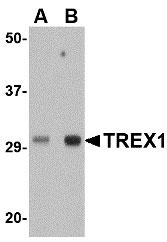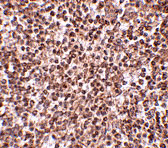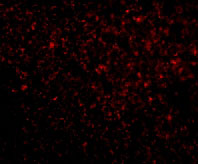TREX1 Antibody
- 产品详情
- 实验流程
- 背景知识
Application
| WB, IF, E, IHC-P |
|---|---|
| Primary Accession | Q9NSU2 |
| Other Accession | NP_057465, 7705353 |
| Reactivity | Human, Mouse, Rat |
| Host | Rabbit |
| Clonality | Polyclonal |
| Isotype | IgG |
| Calculated MW | 33212 Da |
| Concentration (mg/ml) | 1 mg/mL |
| Conjugate | Unconjugated |
| Application Notes | TREX1 antibody can be used for detection of TREX1 by Western blot at 0.5 and 1 µg/mL. Antibody can also be used for immunohistochemistry starting at 2.5 µg/mL. For immunofluorescence start at 20 µg/mL. |
| Gene ID | 11277 |
|---|---|
| Other Names | Three-prime repair exonuclease 1, 3.1.11.2, 3'-5' exonuclease TREX1, DNase III, TREX1 |
| Target/Specificity | TREX1; TREX1 antibody will not cross-react with the related protein TREX2. At least three isoforms of TREX1 are known to exist; this antibody will recognize all three isoforms. |
| Reconstitution & Storage | TREX1 antibody can be stored at 4℃ for three months and -20℃, stable for up to one year. As with all antibodies care should be taken to avoid repeated freeze thaw cycles. Antibodies should not be exposed to prolonged high temperatures. |
| Precautions | TREX1 Antibody is for research use only and not for use in diagnostic or therapeutic procedures. |
| Name | TREX1 {ECO:0000303|PubMed:10391904, ECO:0000312|HGNC:HGNC:12269} |
|---|---|
| Function | Major cellular 3'-to-5' DNA exonuclease which digests single- stranded DNA (ssDNA) and double-stranded DNA (dsDNA) with mismatched 3' termini (PubMed:10391904, PubMed:10393201, PubMed:17293595). Prevents cell-intrinsic initiation of autoimmunity (PubMed:10391904, PubMed:10393201, PubMed:17293595). Acts by metabolizing DNA fragments from endogenous retroelements, including L1, LTR and SINE elements (PubMed:10391904, PubMed:10393201, PubMed:17293595). Plays a key role in degradation of DNA fragments at cytosolic micronuclei arising from genome instability: its association with the endoplasmic reticulum membrane directs TREX1 to ruptured micronuclei, leading to micronuclear DNA degradation (PubMed:33476576). Micronuclear DNA degradation is required to limit CGAS activation and subsequent inflammation (PubMed:33476576). Unless degraded, these DNA fragments accumulate in the cytosol and activate the cGAS-STING innate immune signaling, leading to the production of type I interferon (PubMed:33476576). Prevents chronic ATM-dependent checkpoint activation, by processing ssDNA polynucleotide species arising from the processing of aberrant DNA replication intermediates (PubMed:18045533). Inefficiently degrades oxidized DNA, such as that generated upon antimicrobial reactive oxygen production or upon absorption of UV light (PubMed:23993650). During GZMA-mediated cell death, contributes to DNA damage in concert with NME1 (PubMed:16818237). NME1 nicks one strand of DNA and TREX1 removes bases from the free 3' end to enhance DNA damage and prevent DNA end reannealing and rapid repair (PubMed:16818237). |
| Cellular Location | Nucleus. Cytoplasm, cytosol. Endoplasmic reticulum membrane; Peripheral membrane protein. Note=Retained in the cytoplasm through the C-terminal region (By similarity). Localization to the endoplasmic reticulum membrane is required to direct TREX1 to ruptured micronuclei (PubMed:33476576). In response to DNA damage, translocates to the nucleus where it is specifically recruited to replication foci (PubMed:16818237). Translocation to the nucleus also occurs during GZMA-mediated cell death (PubMed:16818237) {ECO:0000250|UniProtKB:Q91XB0, ECO:0000269|PubMed:16818237, ECO:0000269|PubMed:33476576} |
| Tissue Location | Detected in thymus, spleen, liver, brain, heart, small intestine and colon. |
For Research Use Only. Not For Use In Diagnostic Procedures.
Provided below are standard protocols that you may find useful for product applications.
BACKGROUND
TREX1 Antibody: Trex1 is the major human 3' to 5' exonuclease which is required for checkpoint signaling after DNA damage. It is ubiquitously expressed, binds to single stranded DNA coated with replication protein A that accumulates at sites of DNA damage and recruits the ataxia telangiectasia and Rad3 related protein (ATR), a checkpoint kinase, to sites of DNA damage and replication stress. Trex1 is required for ATR expression. This gene uses two different open reading frames. The upstream ORF encodes proteins which interact with ATR and localize to intranuclear foci induced by DNA damage and are essential components of the DNA damage checkpoint. The downstream ORF encodes proteins with 3' to 5' exonuclease activity and may be a subunit of human DNA polymerase III. Mutations in this gene result in Aicardi-Goutieres syndrome, chilblain lupus, and Cree encephalitis.
REFERENCES
Mazur DJ and Perrino FW. Identification and expression of the TREX1 and TREX2 cDNA sequences encoding mammalian 3→5 exonucleases. J. Biol. Chem. 1999; 274:19655-60.
Cortez D, Guntuku S, Qin J, et. al. ATR and ATRIP: partners in checkpoint signaling. Science 2001 294:1713-6
Stetson DB, Ko JS, Heidmann T, et al. Trex1 prevents cell-intrinsic initiation of autoimmunity. Cell 2008 134:587-98.
Mazur DJ and Perrino FW. Structure and expression of the TREX1 and TREX2 3'→5' exonuclease genes. J. Biol. Chem. 2001; 276:14718-27.
终于等到您。ABCEPTA(百远生物)抗体产品。
点击下方“我要评价 ”按钮提交您的反馈信息,您的反馈和评价是我们最宝贵的财富之一,
我们将在1-3个工作日内处理您的反馈信息。
如有疑问,联系:0512-88856768 tech-china@abcepta.com.























 癌症的基本特征包括细胞增殖、血管生成、迁移、凋亡逃避机制和细胞永生等。找到癌症发生过程中这些通路的关键标记物和对应的抗体用于检测至关重要。
癌症的基本特征包括细胞增殖、血管生成、迁移、凋亡逃避机制和细胞永生等。找到癌症发生过程中这些通路的关键标记物和对应的抗体用于检测至关重要。 为您推荐一个泛素化位点预测神器——泛素化分析工具,可以为您的蛋白的泛素化位点作出预测和评分。
为您推荐一个泛素化位点预测神器——泛素化分析工具,可以为您的蛋白的泛素化位点作出预测和评分。 细胞自噬受体图形绘图工具为你的蛋白的细胞受体结合位点作出预测和评分,识别结合到自噬通路中的蛋白是非常重要的,便于让我们理解自噬在正常生理、病理过程中的作用,如发育、细胞分化、神经退化性疾病、压力条件下、感染和癌症。
细胞自噬受体图形绘图工具为你的蛋白的细胞受体结合位点作出预测和评分,识别结合到自噬通路中的蛋白是非常重要的,便于让我们理解自噬在正常生理、病理过程中的作用,如发育、细胞分化、神经退化性疾病、压力条件下、感染和癌症。








